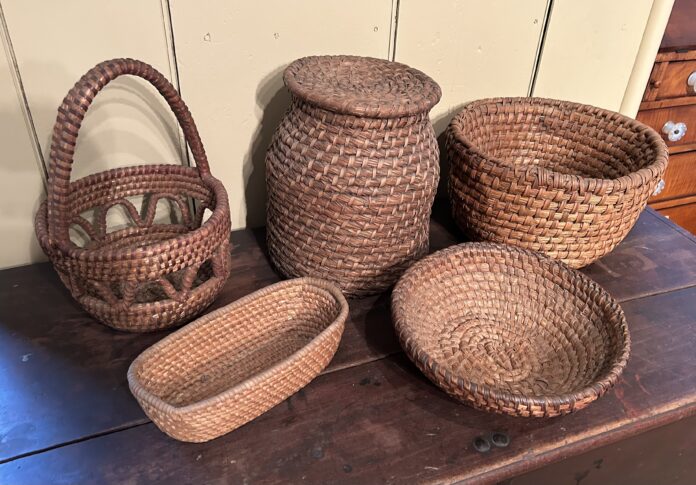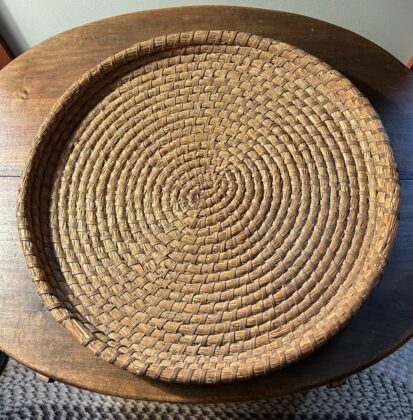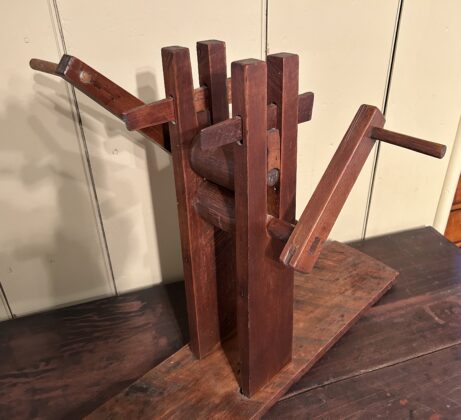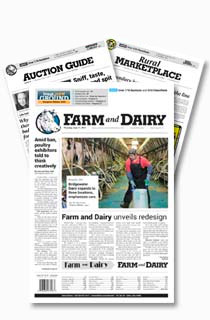
In recent chapters, the making and putting up of apple butter as a means of preserving apples for the winter ahead has been the focus of the narrative. However, this was not the only means of preserving apples, which were a staple of the settlers’ diet. The other method of doing this preserving was to make schnitz.
Schnitz was made by peeling apples, then slicing them thinly to dry. These slices, which could later be reconstituted by soaking them in water, were dried in various ways. One method was to string them on a length of cord that could be hung from rafters in the vicinity of the fireplace, where the ambient heat would dry them. Later, when free-standing cast iron stoves made their debut in the Ohio Country, shipped in from the east aboard canal boats, the schnitz was hung above them in a circular fashion to take advantage of the rising heat.
Probably the most popular means of drying, however, was to lay the slices on large, flat, circular mats made of rye straw where they could dry in the sunshine on a table or bench.
Rye straw
And this brings up another interesting material that was of great importance in the development of early America: rye straw. Rye was a crop traditionally grown by the Pennsylvania Germans for a variety of reasons. The stalks of the rye plant grow to a height twice that of wheat. That, coupled with the fact that rye fiber is a form of cellulose, renders it resistant to decay. This makes it a perfect material for a variety of uses.
In some of the earliest homes in America, rye straw thatch was the material of choice for roofing. By making a thatched roof from bundles of rye straw, the owner of the structure could avoid the tedious, labor-intensive chore of shingle splitting, and thatching didn’t require the use of expensive blacksmith-made nails.
Rye straw was readily available because rye bread was an everyday foodstuff for the Pennsylvania Germans. Wheat was considered a money crop to be sold. The wheat loaf was eaten by these families only on special occasions such as holidays.
As time went by, however, rye straw found an even more important use in the making of rye straw baskets. In this application the rye stalks — which had been soaked in water and then run through wooden rollers to both crush the fibers and remove the water — were twisted into coils. As the basket progressed upward, each coil of straw was laced to the coil below it by using a thin oak wythe. When the basket became as high and wide as the maker wanted it, he or she completely wrapped the upper rim with these oak laces for strength and protection of the fibers. In the finest examples of these baskets, the straw is razored lengthwise several times before weaving in order to make the fibers more pliable and the overall weave tighter and more rigid.
The largest of these baskets — which always had tight-fitting covers also made of rye straw in the same technique — were called schnitz baskets and were used to store dried apple slices. The material was perfect because mice and other vermin were repelled by it and would not try to chew through it because of its sharp, splintery texture. Other smaller rye straw baskets held spinning, weaving and sewing supplies or were used to hold balls of bread dough for rising near the warmth of the fireplace. Still, other forms were used to hold bread at the table, store dried beans or nuts, or be utilized for a wide range of storage purposes. Some of the most desirable of these baskets today feature sections of decorative openwork weaving or were painted.
It is said that weaving rye straw baskets becomes somewhat addictive, and there are instances recorded in which the weaver ultimately created baskets so large they could not be removed from the room in which they were crafted.
Uses
But rye straw had many other uses as well. It could be cut short for stuffing mattresses, used as under-padding for carpets, become bedding in horse stalls or stuffing for horse work collars, as mulch for strawberry plants or sieves for cider pressing, mixed with clay to be used as insulation between cellars and the first floor of houses, used as ties for corn or flax shocks and used to make skeps for bees. Skeps were warmer in the winter and cooler in the summer.
Rye straw was also used to make ties that designated which nut trees in a woods were claimed by a property owner. And there was one additional important use: The hollow stems of the rye straw plant made excellent long drinking straws for sampling the contents of cider and whiskey barrels.
One final perspective on the use of rye straw as it pertained to the preservation of apples was offered by Major General David Sloane Stanley of Wayne County in his memoirs of pioneer Ohio published in 1917. Stanley said, “Apples were placed in cellars and root houses and kept for the winter. Many were simply buried in the ground by making a pyramidal pile of apples, covering it with rye straw, then making a pyramid of earth over the straw. “I remember,” wrote Stanley, “how we were all made happy when an apple hole was opened after New Year’s by making an entrance cut into the pyramid, which strangely was making a hole into a hole.”















